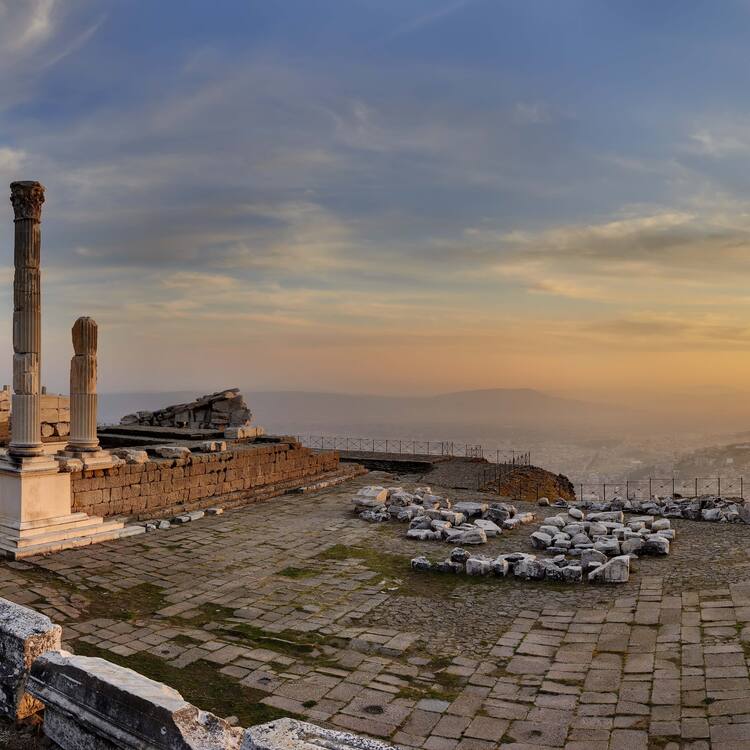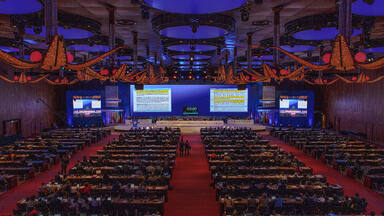Pergame et son paysage culturel à multiples strates
Pergamon and its Multi-Layered Cultural Landscape
This site rises high above the Bakirçay Plain in Turkey’s Aegean region. The acropolis of Pergamon was the capital of the Hellenistic Attalid dynasty, a major centre of learning in the ancient world. Monumental temples, theatres, stoa or porticoes, gymnasium, altar and library were set into the sloping terrain surrounded by an extensive city wall. The rock-cut Kybele Sanctuary lies to the north-west on another hill visually linked to the acropolis. Later the city became capital of the Roman province of Asia known for its Asclepieion healing centre. The acropolis crowns a landscape containing burial mounds and remains of the Roman, Byzantine and Ottoman empires in and around the modern town of Bergama on the lower slopes.
La description est disponible sous licence CC-BY-SA IGO 3.0
Pergame et son paysage culturel à multiples strates
Ce site domine la plaine de Bakirçay dans la région égéenne de la Turquie. L’acropole de Pergame était la capitale de la dynastie hellénistique des Attalides, un des principaux centres du savoir dans le monde antique. Des temples monumentaux, des théâtres, un portique (stoa), un gymnase, un autel et une bibliothèque furent construits à flanc de colline et protégés par un grand mur d’enceinte. Le sanctuaire de Cybèle taillé dans la roche d’une autre colline au nord-ouest répond à l’acropole sur le plan visuel. Plus tard, la ville devint la capitale de la province romaine d’Asie connue pour son asclêpieion, grand centre de cure. L’acropole domine un paysage de tumuli et de vestiges des empires romain, byzantin et ottoman répartis au bas des collines, dans la ville moderne de Bergama et alentour.
La description est disponible sous licence CC-BY-SA IGO 3.0
Pérgamo y su paisaje cultural de estratos múltiples
El sitio se sitúa justo encima de la llanura de Bakirçay, en la costa turca del mar Egeo. La acrópolis de Pérgamo fue la capital de la dinastía helenística de los atálidas y un importante centro del saber en la Antigüedad. Sus templos monumentales, teatros, estoas (pórticos), gimnasio, altar y biblioteca se situaban junto a una colina y estaban protegidos por una amplia muralla circundante. El santuario de Cibeles, tallado en la roca, se encuentra al noroeste, en otra colina visualmente unida a la Acrópolis. Más tarde, la ciudad se convirtió en capital de la provincia romana de Asia y fue conocida por su Asclepeion, o templo curativo. La Acrópolis corona un paisaje que contiene túmulos y vestigios de los imperios romano, bizantino y otomano repartidos al pie de las colinas, en la actual ciudad de Bergama y sus alrededores.
source: UNESCO/CPE
La description est disponible sous licence CC-BY-SA IGO 3.0
ペルガモンとその重層的な文化的景観
ペルガモンは、紀元前3世紀に、ギリシャ人のアッタロス朝の首都として建設された。ヨーロッパと中東を結ぶエーゲ海域という古代世界の心臓部に位置したため、文化、科学、政治の中心地として発展し、ヘレニズム、ローマ、ビザンティン、オスマン帝国の各文化の融合が見られる。バクルジャイ平野とカレの丘という自然地形の中に、ヘレニズム期の建築が見事に融合した稀有な例で、丘には劇場や列柱廊、教育施設のギムナジウム、大祭壇、さらにローマ時代の円形闘技場、大水道、神殿などの遺構が見られる。source: NFUAJ
Pergamon en bijbehorend multi-gelaagd cultuurlandschap
Pergamon en het bijbehorend multi-gelaagd cultuurlandschap stijgen hoog uit boven de Bakirçay vlakte in de Egeïsche regio van Turkije. De acropolis van Pergamon was de hoofdstad van de Hellenistische Attalid dynastie en een belangrijk onderwijscentrum in de oude wereld. Op het glooiende terrein bouwde men binnen een uitgebreide stadsmuur monumentale tempels, theaters, stoa, een gymnasium, altaar en een bibliotheek. Ten noordwesten van en visueel gekoppeld aan de acropolis ligt een andere heuvel met daarop het uit rots gehouwen heiligdom Kybele. Pergamon werd later de hoofdstad van de Romeinse provincie Asia, bekend vanwege het Asclepieion sanatorium. De acropolis is de kroon op de lagere hellingen in en rond de moderne stad Bergama, met grafheuvels en overblijfselen uit het Romeinse, Byzantijnse en Ottomaanse rijk.
Source : unesco.nl
Valeur universelle exceptionnelle
Brève synthèse
Pergame a été fondée au IIIe siècle av. J.-C. comme capitale de la dynastie des Attalides. Située dans la région égéenne, au cœur du monde antique, au carrefour de l’Europe et du Moyen-Orient, elle est devenue un important centre culturel, scientifique et politique. La création de la capitale au sommet de la colline de Kale a planté le décor de la cité. Les terrains très pentus et la plaine de Bakırçay ont été intégrés au plan urbain. Son exceptionnelle composition inclut, entre autres monuments, un théâtre extrêmement pentu, un très long portique (stoa), un gymnase organisé sur trois niveaux, le Grand Autel de Pergame, des tumuli, des canalisations d’eau sous pression, le mur d’enceinte de la ville et le sanctuaire de Cybèle dans l’alignement visuel de la colline de Kale. En tant que capitale des Attalides, Pergame a protégé plusieurs cités à l’époque hellénistique. Puissance politique et artistique, elle a noué des liens très intenses avec les civilisations qui lui étaient contemporaines. La dynastie a fondé à Pergame une des plus grandes bibliothèques du monde antique et la rivalité entre trois dynasties hellénistiques a incité les Attalides à créer la célèbre école de sculpture.
Passée sous domination romaine en 133 av. J.-C., Pergame s’est transformée en métropole et a été la capitale de la province romaine d’Asie à l’époque impériale romaine. Les Romains ont conservé les structures érigées à l’époque hellénistique tout en dotant la ville de nouvelles fonctions, notamment de centre culturel et de centre de culte impérial de l’Empire romain. De nombreuses structures importantes ont ainsi été construites ou développées lors de la période romaine, dont le sanctuaire d’Asclépios, centre de cure réputé dont la source sacrée coule toujours, le théâtre romain, l’un des plus grands amphithéâtres romains, un grand aqueduc, le temple de Trajan et le Serapeum. Durant la période byzantine, en raison du déplacement des routes commerciales et des centres politiques de la région égéenne vers le nord-ouest de l’Anatolie, en particulier à İstanbul (Constantinople), de grand centre hellénistique puis romain, Pergame est devenue une ville de taille moyenne. Elle a néanmoins conservé son importance culturelle et religieuse, abritant une des sept Églises d’Asie (ou de l’Apocalypse). Pergame préserve et illustre aujourd’hui cette transformation.
Avec l’arrivée des Ottomans, Pergame a connu une nouvelle adaptation culturelle, particulièrement manifeste dans la plaine de Bakırçay. Les Ottomans ont doté la ville de toutes les structures urbaines nécessaires, à savoir mosquées, bains, ponts, khans, bedestens (bazars couverts), arastas (marchés ottomans) et réseaux d’adduction d’eau, en s’étendant sur les strates romaine et byzantine. La superposition de ces époques et cultures diverses, tout au long de l’occupation permanente Pergame, est illustrée dans la forme urbaine et l’architecture de la cité, faites de continuités, de formations, de transformations et de détériorations liées à l’existence matérielle et à l’utilisation de l’espace à différentes époques et par différentes cultures.
La continuité d’usage des structures existantes par les cultures suivantes est manifeste avec l’exemple de l’église Saint-Jean, qui a tout d’abord fait partie du Serapeum, un sanctuaire dédié par les Romains à un dieu égyptien, et qui est par la suite devenue une mosquée ottomane, tout en ayant abrité une synagogue juive. À partir du IIIe siècle av. J.-C., la ville a été entourée d’une ceinture de tertres funéraires de différentes tailles, illustrant la volonté de Pergame de s’agrandir dans la plaine de Bakırçay. Outre les tumuli, plusieurs sanctuaires, tels que le sanctuaire de Cybèle à Kapikaya, ont été érigés sur de hautes collines et crêtes montagneuses dans la région environnant la ville. Pergame est le témoignage d’une réalisation esthétique unique et intégrée de plusieurs civilisations. Elle incorpore des structures hellénistiques, romaines, byzantines et ottomanes, qui illustrent le paganisme, le christianisme, le judaïsme et l’islam, tout en préservant leurs caractéristiques culturelles dans le paysage historique.
Critère (i) : la construction de Pergame au sommet la colline de Kale, exploitant la topographie à l’aide de terrasses construites par l’homme et de grands monuments dominant la plaine environnante, est un chef d’œuvre de planification et de conception urbaines hellénistique et romaine. L’acropole est demeurée le sommet de Pergame tandis que la ville s’est développée sur le bas de la colline lors des périodes byzantine et ottomane, étendant sa domination sur le paysage.
Critère (ii) : l’urbanisme, de même que les ouvrages d’architecture et de génie civil de Pergame représentent une synthèse nourrie du contexte cumulatif d’Anatolie. Le sanctuaire de Cybèle à Kapikaya, fort de ses racines anatoliennes, témoigne de l’occupation permanente du site, d’une synthèse des cultures et d’un échange de valeurs humaines au cours du temps. Le Serapeum, temple romain dédié à un dieu égyptien, prouve également cet échange de valeurs humaines, comme le transfert de la météorite de Cybèle à Rome, encouragé par les Attalides.
Critère (iii) : ‘Pergame et son paysage culturel à multi-strates’ constitue un témoignage unique et exceptionnel de la planification urbaine et paysagère hellénistique. Les monuments d’architecture dont l’Asclépiéion, le temple et le sanctuaire de Sérapis, le sanctuaire de Cybèle à Kapikaya et les tumuli sont des témoignages exceptionnels de leur époque, de leur culture et de leur civilisation.
Critère (iv) : l’acropole de Pergame, avec sa planification urbaine et ses vestiges architecturaux, est un ensemble exceptionnel de la période hellénistique. Le temple et sanctuaire de Sérapis, l’Asclépiéion, le réseau d’adduction d’eau et l’amphithéâtre constituent des témoignages de la présence romaine en Anatolie, une période clé de l’histoire. ‘Pergame et son paysage culturel à multi-strates’ est un paysage urbain historique exceptionnel qui témoigne d’importantes étapes de la présence humaine au sein d’un paysage géographique auquel il appartient.
Critère (vi) : Pergame est liée à des personnages éminents, des écoles, des idées et des traditions importantes en matière d’art, d’architecture, de planification, de religion et de science. L’école de sculpture de Pergame a donné naissance au style pergaménien. Le culte de Cybèle est une tradition et une croyance qui se sont perpétuées en Anatolie. Avec la colonisation de l’Anatolie par les Romains, le transfert du culte de Cybèle à Rome par le roi attalide de Pergame et le fait que Rome reçoive Pergame en héritage en conséquence d’un legs attalide en 133 av. J.-C., Pergame est directement associée à la création d’un empire romain oriental. L’utilisation continue à titre religieux du temple de Sérapis – qui a tout d’abord été construit comme temple à l’époque romaine, puis converti et utilisé comme église à la fin de cette même période et durant la période byzantine, tandis que l’une de ses rotondes était utilisée comme synagogue, et qui fait office de mosquée depuis le XIIIe siècle, est un exemple de la continuité d’usage à des fins religieuses d’un lieu donné. Il convient également d’évoquer le médecin, chirurgien et philosophe Galien qui a été formé à Pergame et dont les travaux ont été diffusés depuis cette cité ainsi que la tradition de production de parchemins, une spécificité de Pergame.
Intégrité
‘Pergame et son paysage culturel à multi-strates’ contient tous les éléments nécessaires pour exprimer la valeur universelle exceptionnelle, notamment des perspectives entre le sanctuaire de Cybèle à Kapikaya et l’acropole, ou encore entre les tertres funéraires et l’acropole, et ne souffre pas de négligence.
Authenticité
Les différentes composantes de ‘Pergame et son paysage culturel à multi-strates’ satisfont aux conditions d’authenticité exprimées à travers différents attributs. L’établissement de la période hellénistique sur la colline de Kale, l’Asclépiéion, l’amphithéâtre et le théâtre romain sont authentiques du point de vue de la forme et de la conception, des matériaux, de la substance et de la situation. Le cadre des vestiges hellénistiques et romains sur la colline de Kale est touché par le funiculaire qui court sur le côté est de la colline.
L’authenticité du temple et sanctuaire de Sérapis et ses usages ultérieurs s’exprime à travers la forme et la conception, les matériaux et la substance des vestiges archéologiques. Les constructions de la période ottomane sont conservées conformément aux bonnes pratiques. L’implantation de la ville ottomane est préservée mais l’authenticité de son cadre est touchée par des aménagements dans la zone urbaine survenus lors du dernier quart du XXe siècle. Les ruines romaines au sein de la ville ottomane sont préservées.
L’authenticité de la composante n° 2, le sanctuaire de Cybèle à Kapikaya, s’exprime à travers la forme et la conception, les matériaux et la substance, les traditions, les techniques, la situation et le cadre ainsi que l’esprit et l’impression. Lorsque les tumuli sont envisagés comme des expressions du pouvoir sur le territoire naturel de Pergame à l’Antiquité, ils possèdent ensemble une authenticité de sens et de conception du paysage culturel. Les composantes 1 & 7 ont été touchées par des constructions illégales et la composante 8 par des fouilles illégales.
Éléments requis en matière de protection et de gestion
Tous les sites archéologiques de première catégorie situés sur le territoire du bien inscrit au patrimoine mondial, à savoir la colline de Kale, les aqueducs, l’Asclépiéion, le quartier des plaisirs de l’époque romaine Musalla Mezarlık, le Serapeum, les tumuli et le sanctuaire de Cybèle taillé dans la roche, et les sites urbains sont sous la protection de la Loi nationale de préservation n° 2863. Tous les monuments situés sur le territoire des sites urbains sont également protégés par la Loi nationale de préservation n° 2863. Ces sites urbains constituent la majeure partie des quartiers et zones commerçantes ottomans et la plupart ont un statut de site archéologique de deuxième ou troisième catégories. Toute action de conservation, de préservation ou de construction en rapport avec les monuments, sur le territoire d’un site archéologique et/ou urbain, est soumise à l’approbation du Conseil régional en charge de la conservation-2.
La municipalité de Bergama a élaboré un plan de conservation urbaine en 2012 afin de préserver de concert le site urbain et son voisinage. Les façades sur rue et les spécificités structurelles traditionnelles, notamment les techniques, les matériaux utilisés, l’implantation et le cadre, ont été prises en compte.
La gestion du bien inscrit est coordonnée par le Bureau de la municipalité de Bergama en charge de la gestion du patrimoine mondial, créé fin 2011, et par l’ « Organe consultatif » et l’ « Organe de coordination et de supervision » qui sont responsables de l’adoption et de la mise en œuvre du plan de gestion. Des institutions nationales et locales, des universités, des ONG et un représentant des mukhtars siègent au conseil de ces organes. Un responsable de site a été nommé. Outre le mécanisme de préservation et de conservation actuellement en place, le Bureau de gestion du patrimoine mondial et les organes concernés ont entamé l’élaboration d’un plan de gestion, qui sera le principal outil de coopération et de suivi général de l’ensemble du bien du patrimoine mondial et qui devrait être achevé début 2016.



